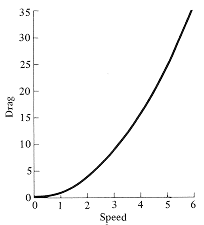| |
Drag
The
drag on a vehicle is a critical quantity in human-powered transportation
due to the low steady state power output capability of the human engine.
Drag opposes the motion of the body and is a measure of the momentum change
of the fluid due to its interaction with the body. This will depend upon the
shape of the body and the Reynolds number of the flow.
The drag force,
FD, can be expressed in terms of a drag coefficient, CD,
the effective body area, A, normal to the flow, and the dynamic pressure,
(rU2/2): FD = CDA(rU2/2).
This expression indicates that the drag on a given body increases as the square
of its speed with respect to the fluid, as shown in the diagram. If a
bicycle is moving with a ground speed of 1 m/s in still air, its velocity with
respect to the air is also 1 m/s. The total aerodynamic drag will be 1/4 of
that experienced if a head-wind of 1 m/s is present when the effective airspeed
is 2 m/s.
Contributions to the drag force come from the skin friction
between the fluid and the solid shape, the pressure difference caused by decelerating
and accelerating the flow as it passes the body, and by flow separation
from the body that will effect the size of the wake region behind the body.
|
|
|
|
|
|
|
|
|
|
|
|

